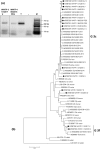Detection and Characterization of Hepatitis E Virus Genotype 3 in Wastewater and Urban Surface Waters in Germany
- PMID: 32172512
- PMCID: PMC7225198
- DOI: 10.1007/s12560-020-09424-2
Detection and Characterization of Hepatitis E Virus Genotype 3 in Wastewater and Urban Surface Waters in Germany
Abstract
In highly populated areas, environmental surveillance of wastewater and surface waters is a key factor to control the circulation of viruses and risks for public health. Hepatitis E virus (HEV) genotype 3 is considered as an emerging pathogen in industrialized countries. Therefore, this study was carried out to determine the prevalence of HEV in environmental waters in urban and suburban regions in Germany. HEV was monitored in water samples using quantitative RT-PCR (RT-qPCR) and nested RT-PCR without or with virus concentration via polyethylene glycol precipitation or ultracentrifugation. By RT-qPCR, 84-100% of influent samples of wastewater treatment plants were positive for HEV RNA. Genotypes HEV-3c and 3f were identified in wastewater, with HEV-3c being the most prevalent genotype. These data correlate with subtypes identified earlier in patients from the same area. Comparison of wastewater influent and effluent samples revealed a reduction of HEV RNA of about 1 log10 during passage through wastewater treatment plants. In addition, combined sewer overflows (CSOs) after heavy rainfalls were shown to release HEV RNA into surface waters. About 75% of urban river samples taken during these CSO events were positive for HEV RNA by RT-qPCR. In contrast, under normal weather conditions, only around 30% of river samples and 15% of samples from a bathing water located at an urban river were positive for HEV. Median concentrations of HEV RNA of all tested samples at this bathing water were below the limit of detection.
Keywords: Combined sewer overflow; Genotyping; Hepatitis E virus; Monitoring; Surface water; Wastewater.
Figures




Similar articles
-
Water-Based Epidemiological Investigation of Hepatitis E Virus in South Africa.Food Environ Virol. 2024 Sep;16(3):338-350. doi: 10.1007/s12560-024-09596-1. Epub 2024 Apr 13. Food Environ Virol. 2024. PMID: 38613652 Free PMC article.
-
Hepatitis A and E Viruses in Wastewaters, in River Waters, and in Bivalve Molluscs in Italy.Food Environ Virol. 2015 Dec;7(4):316-24. doi: 10.1007/s12560-015-9207-3. Epub 2015 Jun 27. Food Environ Virol. 2015. PMID: 26115693
-
Environmental Surveillance of Hepatitis E Virus and Rat Hepatitis E Virus in Portugal and Spain, 2020-2022.J Med Virol. 2025 May;97(5):e70414. doi: 10.1002/jmv.70414. J Med Virol. 2025. PMID: 40407063
-
Hepatitis E in Italy: 5 years of national epidemiological, virological and environmental surveillance, 2012 to 2016.Euro Surveill. 2018 Oct;23(41):1700517. doi: 10.2807/1560-7917.ES.2018.23.41.1700517. Euro Surveill. 2018. PMID: 30326991 Free PMC article.
-
Viruses in Wastewater-A Concern for Public Health and the Environment.Microorganisms. 2024 Jul 14;12(7):1430. doi: 10.3390/microorganisms12071430. Microorganisms. 2024. PMID: 39065197 Free PMC article. Review.
Cited by
-
Hepatitis E virus in pigs and the environment: An updated review of public health concerns.Narra J. 2022 Aug;2(2):e78. doi: 10.52225/narra.v2i2.78. Epub 2022 Aug 1. Narra J. 2022. PMID: 38449702 Free PMC article. Review.
-
Global public health implications of human exposure to viral contaminated water.Front Microbiol. 2022 Aug 30;13:981896. doi: 10.3389/fmicb.2022.981896. eCollection 2022. Front Microbiol. 2022. PMID: 36110296 Free PMC article. Review.
-
Use of Capsid Integrity-qPCR for Detecting Viral Capsid Integrity in Wastewater.Viruses. 2023 Dec 26;16(1):40. doi: 10.3390/v16010040. Viruses. 2023. PMID: 38257740 Free PMC article.
-
Transmission of Hepatitis E Virus.Adv Exp Med Biol. 2023;1417:73-92. doi: 10.1007/978-981-99-1304-6_6. Adv Exp Med Biol. 2023. PMID: 37223860
-
High prevalence of hepatitis E and rat hepatitis E viruses in wastewater in Gothenburg, Sweden.One Health. 2024 Aug 22;19:100882. doi: 10.1016/j.onehlt.2024.100882. eCollection 2024 Dec. One Health. 2024. PMID: 39267918 Free PMC article.
References
-
- Adlhoch C, Avellon A, Baylis SA, Ciccaglione AR, Couturier E, de Sousa R, Epstein J, Ethelberg S, Faber M, Fehér Á, Ijaz S, Lange H, Mandáková Z, Mellou K, Mozalevskis A, Rimhanen-Finne R, Rizzi V, Said B, Sundqvist L, Thornton L, Tosti ME, Van Pelt W, Aspinall E, Domanovic D, Severi E, Takkinen J, Dalton HR. Hepatitis E virus: assessment of the epidemiological situation in humans in Europe, 2014/15. Journal of Clinical Virology. 2016;82:9–16. - PubMed
-
- Alfonsi V, Romanò L, Ciccaglione AR, La Rosa G, Bruni R, Zanetti A, Della Libera S, Iaconelli M, Bagnarelli P, Capobianchi MR, Garbuglia AR, Riccardo F, Tosti ME, Collaborating Group Hepatitis E in Italy: 5 years of national epidemiological, virological and environmental surveillance, 2012 to 2016. Eurosurveillance. 2018;23(41):1700517. - PMC - PubMed
-
- Dalton HR, Kamar N, Izopet J. Hepatitis E in developed countries: Current status and future perspectives. Future Microbiology. 2014;9(12):1361–1372. - PubMed
Publication types
MeSH terms
Substances
LinkOut - more resources
Full Text Sources

